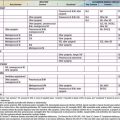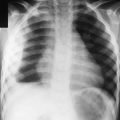Chapter 684 Specific Sports and Associated Injuries
Gymnastics
Treatment in almost all cases involves immobilization for some period, application of ice, and administration of analgesic drugs. If pain persists, the correct diagnosis can be made by MRI or arthroscopic examination to rule out intra-articular tears, loose bodies, or ligamentous instability. The pediatrician should have a low threshold for referral to a hand specialist in a wrist injury that is not improving with rest. Ligamentous laxity can predispose to elbow or shoulder dislocation and ankle sprains. Spine problems include spondylolysis (pars interarticularis stress fracture) and spondylolisthesis (Chapter 671.6) due to repetitive extension loading.
Baseball
Throwing injuries of the elbow and shoulder (especially among pitchers) are the most common baseball injuries (Chapters 679.2 and 679.3). The most important consideration is limitation of the number of pitches and advising players and coaches that they should stop immediately when they experience elbow pain and if it persists, having a medical evaluation. It has been recommended that a young pitcher pitch no more than approximately 6 times the pitcher’s age in years.
Deaths in baseball are rare and are caused by chest wall trauma with the ball (commotio cordis) (Chapter 430) or head injury with the ball or bat. Batting helmets need to be worn properly to try to prevent face and head injuries.
Ballet
Ballet is a very demanding activity that may be associated with delayed menarche and eating disorders in female dancers (Chapter 682). Acute injuries are most often of the lower extremities. As with any repetitive activity, overuse injuries are likely; the key is to make the correct diagnosis and also consider the kinetic chain dysfunction that might have contributed to that injury. A dancer might have an unrehabilitated ankle sprain, causing favoring of that leg, leading to a stress fracture of the contralateral tibia. Foot problems include metatarsal stress fractures, subungual hematomas, calluses and bunions, sesamoiditis, and plantar fasciitis.
Wrestling
Wrestling holds can produce injury owing to various torques or forces applied to the extremities and spine; wrestling throws with subsequent falls can produce concussions, neck strain, or spinal cord injury. The 2 most common sites of injury are the shoulder and knee. “Stingers” and “burners” are due to a brachial plexopathy (see Football).
Shoulder subluxation is common. Patients are often aware of their shoulder’s slipping in and out (Chapter 679.2). Hand injuries are usually not severe and include recurrent metacarpophalangeal and proximal interphalangeal sprains. Treatment of hand injuries includes splinting and taping.
Knee injuries are common and potentially serious and include prepatellar bursitis, medial and lateral sprains, and medial and lateral meniscus tears (Chapter 679.6). Prepatellar bursitis is caused by acute or recurrent traumatic impact to the mat. Swelling occurs over the patella, and patients have no limitation of motion except full flexion. If the skin has been broken, septic bursitis has to be considered. The physician must try to distinguish traumatic from infected bursitis, which can require aspiration of the bursa. Treatment of traumatic bursitis includes protective padding, ice, nonsteroidal anti-inflammatory drugs (NSAIDs), and occasionally aspiration if flexion is impaired. Rarely bursectomy is needed if there are several recurrences.
Football
Knee injuries are the most common musculoskeletal complaint at the time of preseason examinations. Knee injuries are discussed in Chapter 679.6.
Basketball and Volleyball
Knee overuse injuries include patellar tendinosis (jumper’s knee) and traction apophysitis (Osgood-Schlatter disease) (Chapter 669.4). As with other jumping sports, acute ligament sprains (medial collateral with or without anterior cruciate ligaments) can occur.
Running
Shin Splints
Shin splints, or medial tibial stress syndrome, is a descriptive term for diffuse pain over the distal medial tibia and should be distinguished from tibial stress fractures and chronic compartment syndromes (Chapter 679.7). Medial tibial stress syndrome usually occurs in new runners with overpronation.
Tennis
Tennis elbow, or lateral epicondylitis, is due to repetitive overload of the wrist extensor-supinator mechanism, especially the extensor carpi radialis brevis (Chapter 679.3). Medial epicondylitis is caused by repetitive overload of the wrist flexor-pronator muscle groups. This can secondarily involve the medial collateral ligament; however, the ligament is uncommonly the site of the primary injury. Medial epicondylar apophysitis may be associated with ulnar nerve dysfunction. Olecranon apophysitis is similar to Osgood-Schlatter disease and is marked by pain at the olecranon with elbow extension.
Skiing
Lower extremity injuries include fractures (often spiral) of the tibia (“boot top”) and ankle and anterior cruciate ligament sprains with or without tibial eminence fracture. Hemarthrosis is present in fractures and meniscal and anterior cruciate ligament injuries. Treatment is noted in Chapter 669.
Bisset L, Beller E, Jull G, et al. Mobilization with movement and exercise, corticosteroid injection, or wait and see for tennis elbow: randomized trial. BMJ. 2006;333:939-941.
Broderick C, McKay D. Reducing the risk of injury in young footballers. BMJ. 2009;338:667-668.
Christopher NC, Congeni J. Overuse injuries in the pediatric athlete: evaluation, initial management, and strategies for prevention. Clin Pediatr Emerg Med. 2002;3:118-128.
Emery CA, Kang J, Shrier I, et al. Risk of injury associated with body checking among youth ice hockey players. JAMA. 2010;303:2265-2272.
Heidt RS, Sweeterman LM, Carlonas Richelle L, et al. Avoidance of soccer injuries with preseason conditioning. Am J Sport Med. 2000;28:659-662.
Koes BW. Corticosteroid injection for rotator cuff disease. BMJ. 2009;338:245.
Koutures CG, Gregory AJM, Council on Sports Medicine & Fitness. Clinical report—injuries in youth soccer. Pediatrics. 2010;125:410-414.
Krajnik S, Fogarty KJ, Yard EE, et al. Shoulder injuries in US high school baseball and softball athletes, 2005-2008. Pediatrics. 2010;125:497-501.
Lawson BR, Comstock RD, Smith GA. Baseball-related injuries to children treated in hospital emergency departments in the United States, 1994-2006. Pediatrics. 2009;123:e1028-e1034.
Link MS, Bir C, Cau N, et al. Protecting our children from the consequences of chest blows on the playing field: a time for science over marketing. Pediatrics. 2008;122:437-439.
Mallen CD, Chesterson LS, Hay EM. Tennis elbow. BMJ. 2010;340:212-213.
McClain LG, Reynolds S. Sports injuries in a high school. Pediatrics. 1989;84:446-450.
McCrory PR. Brain injury and heading in soccer. BMJ. 2003;327:351-352.
Nysted M, Drogset JO. Trampoline injuries. Br J Sports Med. 2006;40:984-987.
Ramirez M, Yang J, Bourque L, et al. Sports injuries to high school athletes with disabilities. Pediatrics. 2009;123:690-696.
Schwellnus MP, Drew N, Collins M. Muscle cramping in athletes—risk factors, clinical assessment and management. Clin Sports Med. 2008;27:183-194.
Smidt N, van der Windt DAWM. Tennis elbow in primary care. BMJ. 2006;333:927-928.
Smidt N, van der Windt DAWM, Assendelft JJ, et al. Corticosteroid injections, physiotherapy, or a wait-and-see policy for lateral epicondylitis: a randomized controlled trial. Lancet. 2002;359:657-662.
Speed CA. Corticosteroid injections in tendon lesions. BMJ. 2001;323:382-386.
University Interscholastic League. Preparticipation physical evaluation, 2002. (website) www.uiltexas.org/athletics/forms Accessed November 12, 2010
Yang J, Peek-Asa C, Allareddy V, et al. Patient and hospital characteristics associated with length of stay and hospital charges for pediatric sports-related injury hospitalizations in the United States, 2000-2003. Pediatrics. 2007;119:e813-e820.




